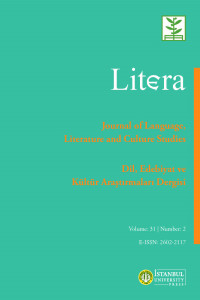Öz
Bu çalışmada, Mario Vargas Llosa’nın Lituma en los Andes (And Dağları’nda Terör) adlı romanındaki anlatı yapısı; anlatıcı, anlatı kipleri ve zamansal çerçeve gibi öğeler açısından incelenmektedir. 1960’lı yıllarda ortaya çıkan ve Latin Amerika Edebiyatı’nın dünya çapında dikkat çekmesini sağlayan “boom” adlı dönemin yazarlarından biri olan Mario Vargas Llosa yapıtlarında yenilikçi teknikleri ustalıkla kullanır. 1993 yılında yayımladığı And Dağları’nda Terör adlı eseri de öykü içinde öyküleri, labirenti andıran yapısal özellikleri ve kurgusu bakımından zengin bir yapıttır. Romanda ana öykü, And’larda bir dağ köyü olan Naccos’taki bir karakolda görevli olan Çavuş Lituma ile yardımcısı Er Tomás’ın kısa bir süre önce kaybolmuş olan üç kişiyi bulmaya ve aslında ne olduğunu çözmeye çalışması etrafında şekillenir. Lituma’nın bu iz sürme macerası ise anlatıyı bir yandan Aydınlık Yol (Sendero Luminoso) gerillalarının bölgede yarattığı terör ortamına, diğer yandan ise gulyabaniler, apular gibi efsanelere götürür. Anlatıda, zaman ve bakış açısında yapılan değişikliklerle birçok başka öykünün de aralara serpiştirildiği ve her birinin, geçmiş ile şimdi arasında geçişler yapılarak yazar tarafından ustaca örüldüğü görülür. Bu bağlamda çalışmanın amacı, Fransız düşünür Gérard Genette’in Anlatının Söylemi: Yöntem Hakkında Bir Deneme adlı eserinde etraflıca ele aldığı ve Marcel Proust’un Kayıp Zamanın İzinde adlı eserine uyguladığı yöntemi ana hatlarıyla açıklamak ve And Dağları’nda Terör romanını bu teoriye göre inceleyerek eserin yapısını ortaya koymaktır.
Anahtar Kelimeler
Mario Vargas Llosa And Dağları’nda Terör Latin Amerika Edebiyatı Gérard Genette Anlatının söylemi
Kaynakça
- Çıraklı, M. Z. (2015). Anlatıbilim: Kuramsal Okumalar. Ankara: Hece Yayınları. google scholar
- Dervişcemaloğlu, B. (2016). Anlatıbilime Giriş. İstanbul: Dergah Yayınları. google scholar
- Genette, G. (2011). Anlatının Söylemi: Yöntem Hakkında Bir Deneme. (F. B. Aydar, Çev.). İstanbul: Boğaziçi Üniversitesi Yayınevi. google scholar
- Gnutzmann, R. (2007). Novela y cuento del siglo XXen el Peru. Alicante: Cuadernos de America sin nombre. google scholar
- Kıran, A. E. ve Kıran, Z. (2011). Yazınsal Okuma Süreçleri. Ankara: Seçkin Yayıncılık. google scholar
- Mario Vargas Llosa. (2021). Britannica içinde. Erişim adresi: https://bit.ly/37nBnqq. google scholar
- Sanabria, L. (2011). Los impostores del poder en La ciudad y los perros de Mario Vargas Llosa. Especulo, 47, Erişim adresi: http://bit.ly/2uNT54c. google scholar
- Vargas Llosa, M. (1996). And Dağları’nda Terör. (İ. Kut, Çev.). İstanbul: Can Yayınları. google scholar
- Vargas Llosa, M. (1997). Cartas a un joven novelista. Barcelona: Editorial Planeta. google scholar
- Vargas Llosa, M. (1975). La O^a Perpetua, FlaubertyMadame Bovary. Barcelona: Editorial Seix Barral S.A. google scholar
Öz
This study examines the narrative structure in Mario Vargas Llosa’s novel Death in the Andes in terms of elements such as the narrator, narrative modes and temporal framework. Vargas Llosa, one of the authors of the so called “boom” period, which emerged in the 1960s and made Latin American literature attract worldwide attention, skillfully uses innovative techniques in his works. His novel Death in the Andes, published in 1993, offers a multi-layered lecture by presenting a story within the story, a labyrinthine structure and fiction. In the novel, the main story revolves around Sergeant Lituma and his deputy Tomás, who are on duty at a police station in Naccos, a mountain village in the Andes, trying to find three people who had recently disappeared and figure out what actually happened. Lituma’s adventure of investigation takes the narration to the terror environment created by the Shining Path (Sendero Luminoso) guerrillas in the region and also to legends such as ghouls and apus. Also, it’s seen that the author brings together many different stories and skillfully connects them using transitions between the past and present. In this context, the aim of the study is firstly to outline the method elaborated by the French philosopher Gérard Genette in his book The Narrative Discourse An Essay in Method and applied to the novel In Search of Lost Time by Marcel Proust, and secondly to examine the novel Death in the Andes according to this theory.
Anahtar Kelimeler
Mario Vargas Llosa Death in the Andes Latin American Literature Gérard Genette Narrative discourse
Kaynakça
- Çıraklı, M. Z. (2015). Anlatıbilim: Kuramsal Okumalar. Ankara: Hece Yayınları. google scholar
- Dervişcemaloğlu, B. (2016). Anlatıbilime Giriş. İstanbul: Dergah Yayınları. google scholar
- Genette, G. (2011). Anlatının Söylemi: Yöntem Hakkında Bir Deneme. (F. B. Aydar, Çev.). İstanbul: Boğaziçi Üniversitesi Yayınevi. google scholar
- Gnutzmann, R. (2007). Novela y cuento del siglo XXen el Peru. Alicante: Cuadernos de America sin nombre. google scholar
- Kıran, A. E. ve Kıran, Z. (2011). Yazınsal Okuma Süreçleri. Ankara: Seçkin Yayıncılık. google scholar
- Mario Vargas Llosa. (2021). Britannica içinde. Erişim adresi: https://bit.ly/37nBnqq. google scholar
- Sanabria, L. (2011). Los impostores del poder en La ciudad y los perros de Mario Vargas Llosa. Especulo, 47, Erişim adresi: http://bit.ly/2uNT54c. google scholar
- Vargas Llosa, M. (1996). And Dağları’nda Terör. (İ. Kut, Çev.). İstanbul: Can Yayınları. google scholar
- Vargas Llosa, M. (1997). Cartas a un joven novelista. Barcelona: Editorial Planeta. google scholar
- Vargas Llosa, M. (1975). La O^a Perpetua, FlaubertyMadame Bovary. Barcelona: Editorial Seix Barral S.A. google scholar
Ayrıntılar
| Birincil Dil | Türkçe |
|---|---|
| Konular | Sanat ve Edebiyat |
| Bölüm | Araştırma Makaleleri |
| Yazarlar | |
| Yayımlanma Tarihi | 6 Aralık 2021 |
| Gönderilme Tarihi | 22 Mart 2021 |
| Yayımlandığı Sayı | Yıl 2021 Cilt: 31 Sayı: 2 |


